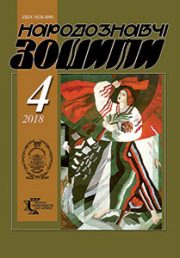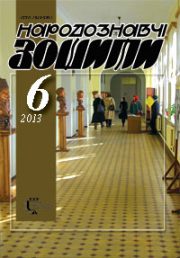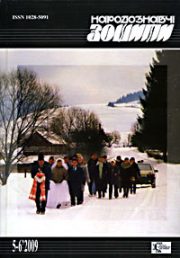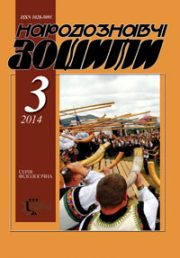The Ethnology Notebooks, 2018, № 5 (143), 1326
DOI https://doi.org/10.15407/nz2018.05.1326
Received 19.07.2018
ORCID ID: https://orcid.org/0000-0002-4957-1619
Kanapljanikov Dmytro, a bread-winner is on the century of historical sciences
department of the modern ethnology
of the Institute of Ethnology
of the National Academy of Sciences of Ukraine
Svobody Avenue 15, 79000, Lviv, Ukraine.
Contacts: zvyczaj@gmail.com
Tel. Тел. +380682478385
Abstrakt. Belarusian traditional Personhood by studies the Belarusian myths and rituals, the stories and thoughts about fairies — «Vanishing People», «invisible peoples» — are researched. Belarusian myths and rituals about «invisible people», both with Western European myths about elves and fairies, create a European area of representations about «invisible people». The feature of the eastern part of this area, which includes the Belarusians, is the presence of rituals and priests of this cult. According to the stories about these beings, they have a human entities, support to each other, as well as with people, economic and social ties. The person, by traditional Belarusians worldview, is social minded entity, and may have supernatural and metamorphosis property.
Keywords: Vanishing People, elf, fairy, Personhood, Person, European mythology, Belarusian mythology, deities of local, European paganism.
REFERENCES
Toŭstsik, T. TS. Arkhiŭ Homel′skaĭ haradskoĭ krai͡aznaŭchaĭ arhanizatsyi “Talaka”. — Aŭdyi͡okaseta No 5/2003 “Turaŭshchyna — 2003″ (2003) [in Belarusian].
Bandarchyk, V.K., Kabashnikaŭ, K.P., Fi͡adosik, A.S., & Bartashėvich, H.A. (1992). Zamovy. Minsk: Navuka i tėkhnika [in Belarusian].
Belova, O.V. (2001). Bibleĭskie si͡uzhety v vostochnoslavi͡anskikh narodnykh legendakh. In O.V. Belova, A.A. Plotnikova, E.E. Levkievskai͡a, & S.M. Tolstai͡a (Eds.), Vostochnoslavi͡anskiĭ ėtnolingvisticheskiĭ sbornik. Issledovanii͡a i materialy (pp. 118—150). Moskva: Indrik [in Russian].
Halaichuk, V. (2013). Tradytsiini uiavlennia pro domovyka na istoryko-etnohrafichnii Volyni. Visnyk of the Lviv University. Series History, 48, 343—382 [in Ukrainian].
Dobrovolʹskīĭ, V.N. (1891). Smolenskīĭ ėtnograficheskīĭ sbornik. S.-Peterburg: Tip. E. Evdokimova [in Russian, Belarusian].
Kazakova, I.V. (1995). Ėtnichnyi͡a tradytsyi i dukhoŭnai͡a kul′tu. Minsk: Universitėtskae [in Belarusian].
Lis, A.S., & I͡Alataŭ, V.I. (1974). Z͡Hniŭnyi͡a pesni. Minsk: Navuka i tėkhnika [in Belarusian].
Lopatin, G.I. (2005). “Li͡udzeĭ zha ni͡avidzimykh stolʹki, skolʹki vidzimykh” Belorusskie mifologicheskie vierovanii͡a v “dobrokhozhikh.” ZHivai͡a Starina, 3, 34–37 [in Russian, Belarusian].
Novak, V.S. (2000). Krynits karmi͡anskikh perazvony: Abrady i pesni ŭ suchas. zapisakh. Homel′: Homel. tsėntr navuk.-tėkhn. i dzelavoĭ infarm [in Belarusian].
Novak, V.S. (2002). Mi͡astsovai͡a spetsyfika I͡Ur’eŭskikh abradaŭ i pesen′. Vesnik Mazyrskaha DZi͡arz͡haŭnaha Pedahahichnaha Universitėta, 7, 57—66 [in Belarusian].
Novak, V.S. (2009). Slavi͡anskai͡a mifalohii͡a (na matėryi͡alakh Homel′skaĭ voblastsi). Minsk: Prava i ėkanomika [in Belarusian].
Novak, V.S. (2010). Mifalahichnyi͡a ŭi͡aŭlenni belarusaŭ. Minsk: Prava i ėkanomika [in Belarusian].
Pashina, O.A. (1998). Arealʹnoe chlenenie Smolenshchiny s tochki zrenii͡a zhatvennoĭ obri͡adnosti. In T.A. Agapkina, A.F. ZHuravlev, & S.M. Tolstai͡a (Eds.), Slovo i kulʹtura: Pami͡ati Nikity Ilʹicha Tolstogo (Vol. 2, pp. 148—157). Moskva: Indrik [in Russian].
Romanov, E.R. (1891). Bělorusskij sbornik: Vyp. 4. Skazki kosmogoničeskìâ i kul’turnyâ. Vitebsk: Tipo-Litografìâ G.A. Malkina [in Russian, Belarusian].
Romanov, E.R. (1893). Belorusskiĭ sbornik: Vyp. 5: Zagovory, apokrify, dukhovnye stikhi. Vitebsk: Tip.-lit. G. A. Malkina [in Russian, Belarusian].
Sheĭn, P.V. (1893). Materialy dli͡a izuchenii͡a byta i i͡azyka russkogo naselenii͡a Severo-Zapadnogo krai͡a (Vol. 2). Sankt-Peterburg: Tipografii͡a Imperatorskoĭ akademii nauk [in Russian, Belarusian].
Briggs, K. (1978). An encyclopedia of fairies : hobgoblins, brownies, bogies, and other supernatural creatures. New York: Pantheon Books [in Belarusian].
Briggs, K.M. (1978). The vanishing people : fairy lore and legends. New York: Pantheon Books.
Flower, H. I. (2017). The dancing lares and the serpent in the garden : religion at the Roman street corner. Princeton ; Oxford: Princeton University.
Hallowell, A.I. (1976). Ojibwa Ontology, Behavior and World View. In Contributions to anthropology: selected papers of A. Irving Hallowell (pp. 357–390). Chicago: University of Chicago Press.
Harvey, G. (2014). The handbook of contemporary animism. Abingdon, Oxon ; New York: Routledge.
Rieti, B. (1991). Strange terrain : the fairy world in Newfoundland. St. John’s, Nfld., Canada: Institute of Social and Economic Research, Memorial University of Newfoundland.
Zinchuk, M. (2017). Lisovyk. Demonolohichna rozpovid Chernihivshchyny. Retrieved from http://proridne.org/Українські народні демонологічні розповіді/Лісовик.html [in Ukrainian].
Kanapli͡anikaŭ, D.H. (2018). Etnagraficzny_Archiu_Kanaplianikau_Zmitro. Retrieved from https://drive.google.com/drive/folders/1n8qPHeRbiryCNuaO–n0IO579lSNDC-r?usp=sharing [in Belarusian].
Lapatsin, H.I. (2017). Ne sama i͡a vas prashu, prosi͡a vas mesi͡ats, krasnae solnyshka: vopyt tėkstalahichnaha kamentara da adnoĭ zamovy. Retrieved from http://vetka-museum.by/publikatsyi-supratso-nika/428-ne-sama-ya-vas-prashu-prosya-vas-mesyats-krasnae-solnyshka-vopyt-tekstalagichnaga-kamentara-da-adnoj-zamovy.html [in Belarusian].
Lopatin, G.I. (2008). O narodnoĭ demonologii belorussko-bri͡anskogo pogranichʹi͡a: dobrokhozhie, nevidimye i dr. Retrieved from http://vetka-museum.by/publikatsyi-supratso-nika/146-o-narodnoj-demonologii-belorussko-bryanskogo-pogranichya-dobrokhozhie-nevidimye-i-dr.html [in Russian, Belarusian].
Jón Árnason. (2013). Huldumanna genesis. Retrieved from http://norroen.info/src/tales/alfa/genesis/is.html (Original work published 1862) [in Icelandic].
Tobar an Dualchais / Kist o Riche. (2018). Retrieved from http://www.tobarandualchais.co.uk/en/more [in Scots, Gaelic, English].







